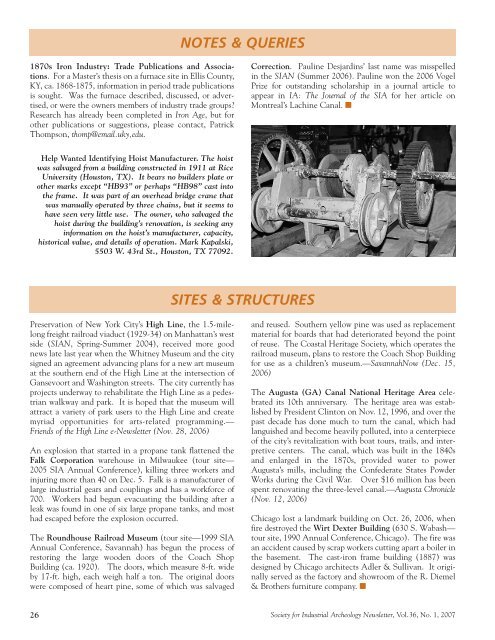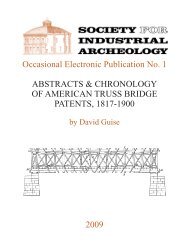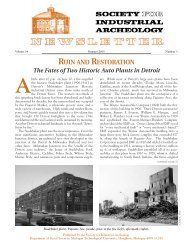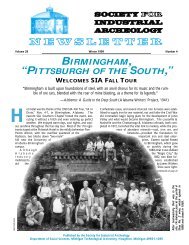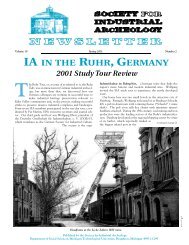SIAN - Society for Industrial Archeology
SIAN - Society for Industrial Archeology
SIAN - Society for Industrial Archeology
Create successful ePaper yourself
Turn your PDF publications into a flip-book with our unique Google optimized e-Paper software.
NOTES & QUERIES1870s Iron Industry: Trade Publications and Associations.For a Master’s thesis on a furnace site in Ellis County,KY, ca. 1868-1875, in<strong>for</strong>mation in period trade publicationsis sought. Was the furnace described, discussed, or advertised,or were the owners members of industry trade groups?Research has already been completed in Iron Age, but <strong>for</strong>other publications or suggestions, please contact, PatrickThompson, thomp@email.uky,edu.Correction. Pauline Desjardins’ last name was misspelledin the <strong>SIAN</strong> (Summer 2006). Pauline won the 2006 VogelPrize <strong>for</strong> outstanding scholarship in a journal article toappear in IA: The Journal of the SIA <strong>for</strong> her article onMontreal’s Lachine Canal. ■Help Wanted Identifying Hoist Manufacturer. The hoistwas salvaged from a building constructed in 1911 at RiceUniversity (Houston, TX). It bears no builders plate orother marks except “HB93” or perhaps “HB98” cast intothe frame. It was part of an overhead bridge crane thatwas manually operated by three chains, but it seems tohave seen very little use. The owner, who salvaged thehoist during the building’s renovation, is seeking anyin<strong>for</strong>mation on the hoist’s manufacturer, capacity,historical value, and details of operation. Mark Kapalski,5503 W. 43rd St., Houston, TX 77092.SITES & STRUCTURESPreservation of New York City’s High Line, the 1.5-milelongfreight railroad viaduct (1929-34) on Manhattan’s westside (<strong>SIAN</strong>, Spring-Summer 2004), received more goodnews late last year when the Whitney Museum and the citysigned an agreement advancing plans <strong>for</strong> a new art museumat the southern end of the High Line at the intersection ofGansevoort and Washington streets. The city currently hasprojects underway to rehabilitate the High Line as a pedestrianwalkway and park. It is hoped that the museum willattract a variety of park users to the High Line and createmyriad opportunities <strong>for</strong> arts-related programming.—Friends of the High Line e-Newsletter (Nov. 28, 2006)An explosion that started in a propane tank flattened theFalk Corporation warehouse in Milwaukee (tour site—2005 SIA Annual Conference), killing three workers andinjuring more than 40 on Dec. 5. Falk is a manufacturer oflarge industrial gears and couplings and has a work<strong>for</strong>ce of700. Workers had begun evacuating the building after aleak was found in one of six large propane tanks, and mosthad escaped be<strong>for</strong>e the explosion occurred.The Roundhouse Railroad Museum (tour site—1999 SIAAnnual Conference, Savannah) has begun the process ofrestoring the large wooden doors of the Coach ShopBuilding (ca. 1920). The doors, which measure 8-ft. wideby 17-ft. high, each weigh half a ton. The original doorswere composed of heart pine, some of which was salvagedand reused. Southern yellow pine was used as replacementmaterial <strong>for</strong> boards that had deteriorated beyond the pointof reuse. The Coastal Heritage <strong>Society</strong>, which operates therailroad museum, plans to restore the Coach Shop Building<strong>for</strong> use as a children’s museum.—SavannahNow (Dec. 15,2006)The Augusta (GA) Canal National Heritage Area celebratedits 10th anniversary. The heritage area was establishedby President Clinton on Nov. 12, 1996, and over thepast decade has done much to turn the canal, which hadlanguished and become heavily polluted, into a centerpieceof the city’s revitalization with boat tours, trails, and interpretivecenters. The canal, which was built in the 1840sand enlarged in the 1870s, provided water to powerAugusta’s mills, including the Confederate States PowderWorks during the Civil War. Over $16 million has beenspent renovating the three-level canal.—Augusta Chronicle(Nov. 12, 2006)Chicago lost a landmark building on Oct. 26, 2006, whenfire destroyed the Wirt Dexter Building (630 S. Wabash—tour site, 1990 Annual Conference, Chicago). The fire wasan accident caused by scrap workers cutting apart a boiler inthe basement. The cast-iron frame building (1887) wasdesigned by Chicago architects Adler & Sullivan. It originallyserved as the factory and showroom of the R. Diemel& Brothers furniture company. ■26 <strong>Society</strong> <strong>for</strong> <strong>Industrial</strong> <strong>Archeology</strong> Newsletter, Vol.36, No. 1, 2007


